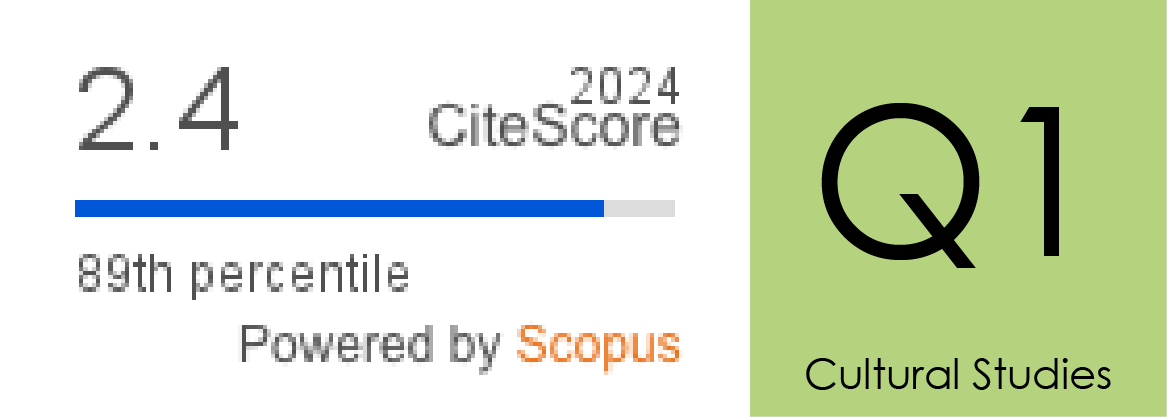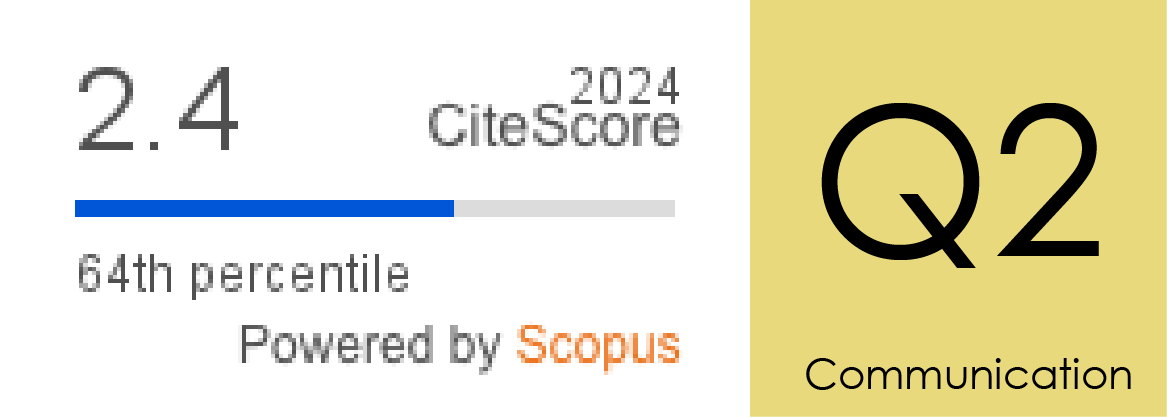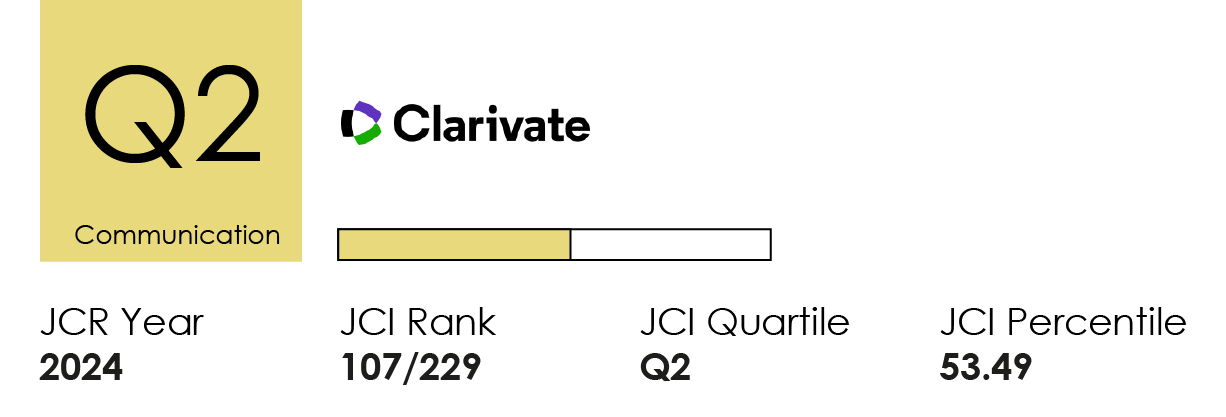Branded content y moda de lujo: análisis de los contenidos audiovisuales en YouTube (2008-2019)
DOI:
https://doi.org/10.14198/MEDCOM.20643Palabras clave:
Branded content, moda de lujo, YouTube, engagement, análisis de contenidoResumen
Las redes sociales y la democratización de la moda han impactado en las estrategias comunicativas del sector del lujo. Este artículo realiza un análisis descriptivo a través del análisis de contenido de todos los vídeos alojados —4079— en los canales de YouTube de las 12 principales marcas de moda de lujo. El principal objetivo es conocer la evolución de los contenidos audiovisuales de las principales marcas de moda de lujo en YouTube e identificar los principales formatos utilizados. Los resultados aportan una clasificación de los principales formatos utilizados por el sector del lujo, así como su capacidad de interacción. La investigación concluye que las marcas de moda de lujo usan más formatos convencionales que estrategias de contenido asociadas al branded content. Del mismo modo, se aprecia que las marcas de moda de lujo apenas interaccionan con su público objetivo.
Citas
Aliferis, G. (14/08/2017). How luxury brands are mastering social content. Global Marketing Alliance. http://bit.ly/3frxGUC
Anjelic, A. (24/09/2019). The problem with luxury fashion’s YouTube strategy. Glossy. http://bit.ly/3CbOlWd
Ashley, C. & Tuten, T. (2015). Creative Strategies in Social Media Marketing: An Exploratory Study of Branded Social Content and Consumer Engagement. Psychology and Marketing, 32(1), 15-27. http://dx.doi.org/10.1002/mar.20761
Bazi, S.; Filieri, R. & Gorton, M. (2020). Customers’ motivation to engage with luxury brands on social media. Journal of Business Research, 112, 223-235. http://dx.doi.org/10.1016/j.jbusres.2020.02.032
BCMA Spain (18/11/2020). Presentación FOCO 17 nov 2020 [Vídeo]. YouTube. http://bit.ly/3Cctzpd
Blank, G. (08/05/2020). The Crossover of Luxury Fashion and YouTube. The fashion institute. http://bit.ly/3ls8m4M
Carrión, P. (10/07/2019). Ranking de las marcas de lujo más valiosas de 2019. Kantar. http://bit.ly/3CcPbBX
Castelló-Martínez, A. y Barrilero-Carpio, C. (2021). La estrategia de contenidos en YouTube de los principales anunciantes españoles. aDResearch ESIC International Journal of Communication Research, 25(25), 44-69. http://dx.doi.org/10.7263/adresic-025-03
Castelló-Martínez, A. y Del Pino-Romero, C. (2018). Los contenidos de marca: una propuesta taxonómica. Revista de Comunicación de la SEECI, 47, 125-142. http://dx.doi.org/10.15198/seeci.2018.0.125-142
Castelló-Martínez, A.; Del Pino-Romero, C. y Tur-Viñes, V. (2016). Estrategias de contenido con famosos en marcas dirigidas a público adolescente. Revista ICONO14, 14(1), 123-154. http://dx.doi.org/10.7195/ri14.v14i1.883
Costa-Sánchez, C. y Túñez-López, M. (2019). Contenidos audiovisuales en social media. Análisis comparativo de Facebook y Youtube. Fonseca, Journal of Communication, 19, 223-236. http://dx.doi.org/10.14201/fjc201919223236
De-Aguilera-Moyano, M.; Castro-Higueras, A. y Pérez-Rufí, P. (2019). Entre broadcast yourself y broadcast whatever: la página de inicio de YouTube como síntesis de su estrategia empresarial. El profesional de la información, 28(2), 1-14. http://bit.ly/2VllqhO
Deloitte. (2019). Las potencias globales de artículos de lujo 2019. http://bit.ly/3rUQHDX
Díaz Soloaga, P. (2014). Comunicación y gestión de marcas de moda. Barcelona: Gustavo-Gili.
Díaz Soloaga, P. & García Guerrero, L. (2016). Fashion films as a new communication format to build fashion brands. Communication and Society, 29(2), 45-61. http://dx.doi.org/10.15581/003.29.2.45-61
Duffett, R. (2020). The youtube marketing communication effect on cognitive, affective and behavioural attitudes among generation Z consumers. Sustainability, 12, 5075. http://dx.doi.org/10.3390/su12125075
Duong, V. C. & Sung, B. (2021). Examining the role of luxury elements on social media engagement. Journal of Global Fashion Marketing, 12(2), 103-119. http://dx.doi.org/10.1080/20932685.2020.1853585
García, A. (29/07/2018). Top 10: estas son las marcas de lujo más valiosas del mundo en 2018. Forbes México. http://bit.ly/3A61RJ2
Godey, B.; Manthiou, A.; Pederzoli, D.; Rokka, J.; Aiello, G.; Donvito, R. & Singh, R. (2016). Social media marketing efforts of luxury brands: Influence on brand equity and consumer behavior. Journal of Business Research, 69(12), 5833-5841. http://dx.doi.org/10.1016/j.jbusres.2016.04.181
Hanke, M. (2015). How Luxury Fashion Brands Utilize YouTube to Engage Consumers and Promote Brand Identity. The Elon Journal of Undergraduate Research in Communications, 6(1), 69-77. http://bit.ly/3jizpwL
Heine, K. & Berghaus, B. (2014). Luxury goes digital: How to tackle the digital luxury brand-consumer touchpoints. Journal of Global Fashion Marketing, 5(3), 223-234. http://dx.doi.org/10.1080/20932685.2014.907606
Hennigs, N.; Wiedmann, K. & Klarmann, C. (2012). Luxury Brands in the Digital Age – Exclusivity versus Ubiquity. Marketing Review St. Gallen, 29(1), 30-35. http://dx.doi.org/10.1007/s11621-012-0108-7
Kapferer, J. N. (2014). The future of luxury: Challenges and opportunities. Journal of Brand Management, 21(9), 716-726. http://dx.doi.org/10.1057/bm.2014.32
Kapferer, J. N. & Bastien, V. (2009). The specificity of luxury management: Turning marketing upside down. Journal of Brand Management, 16(6), 311-322. http://dx.doi.org/10.1057/bm.2008.51
Khan, G. F. & Vong, S. (2014). Virality over youtube: An empirical analysis. Internet Research, 24(5), 629-647. http://dx.doi.org/10.1108/IntR-05-2013-0085
Kim, A. J. & Ko, E. (2010). Impacts of Luxury Fashion Brand’s Social Media Marketing on Customer Relationship and Purchase Intention. Journal of Global Fashion Marketing, 1(3), 164-171. http://dx.doi.org/10.1080/20932685.2010.10593068
López-Navarrete, A. J.; Cabrera-Mendez, M.; Diez-Somavilla, R. & Calduch-Losa, A. (2021). Formula for measuring the engagement of the viewer on YouTube: Exploratory research on the main Spanish youtubers. Revista Mediterránea de Comunicación, 12(1), 143-156. http://dx.doi.org/10.14198/MEDCOM000013
Mason, A. N.; Narcum, J. & Mason, K. (2021). Social media marketing gains importance after Covid-19. Cogent Business & Management, 8(1), 1-17. http://dx.doi.org/10.1080/23311975.2020.1870797
Ng, M. (2014). Social media and luxury fashion brands in China: the case of Coach. Journal of Global Fashion Marketing, 5(3), 251-265. http://dx.doi.org/10.1080/20932685.2014.907607
Okonkwo, U. (2010). Luxury Online. Styles, Systems, Strategies. London: Palgrave Macmillan.
Pérez-Curiel, C. y Sanz-Marcos, P. (2019). Estrategia de marca, influencers y nuevos públicos en la comunicación de moda de lujo. Tendencia Gucci en Instragram. Prisma Social, 24, 1-24. http://bit.ly/37h1Buz
Phillips, N. (24/08/2020). El futuro de las compras de lujo, en mano de las nuevas generaciones. Vogue. http://bit.ly/3lpPOSG
Del Pino Romero, C. y Castelló Martínez, A. (2015). La comunicación publicitaria se pone de moda: branded content y fashion films. Revista de Mediterránea de Comunicación, 6(1), 105-128. http://dx.doi.org/10.14198/medcom2015.6.1.07
Ramos-Serrano, M. & Herrero-Diz, P. (2016). Unboxing and brands: youtubers phenomenon through the case study of evantubehd. Prisma Social, 90-120. http://bit.ly/3jgGnlY
Ramos-Serrano, M. y Jiménez-Marín, G. (2014). Blogs y Moda: cuando los usuarios crean las tendencias. En D. Fernández-Quijada y M. Ramos-Serrano (Eds.), Tecnologías de la persuasión: uso de las TIC en publicidad y relaciones públicas (pp. 131-143). Barcelona: UOC.
Ramos-Serrano, M. y Pineda, A. (2009). El advertainment y las transformaciones de los formatos en el ámbito publicitario: el caso de los fashion films. Trípodos, 2, 729-737. http://hdl.handle.net/11441/28879
Rees-Roberts, N. (2020). After fashion film: social video and brand content in the influencer economy. Journal of Visual Culture, 19(3), 405-421. http://dx.doi.org/10.1177/1470412920964907
Rocamora, A. (2016). Mediatization and Digital Media in the Field of Fashion. Fashion Theory, 21(5), 505-522. http://dx.doi.org/10.1080/1362704X.2016.1173349
Sánchez Cobarro, P. (2018). Branded content y entertainment: un impulso para las organizaciones / Branded content and entertainment: a challenge for organizations. Revista de Comunicación de la SEECI, 0(45), 43. http://dx.doi.org/10.15198/seeci.2018.45.43-54
Segarra-Saavedra, J. e Hidalgo-Marí, T. (2018). Influencers, moda femenina e Instagram: el poder de la influencia en la era 2.0. Revista Mediterránea de Comunicación, 9(1), 313-325. http://dx.doi.org/10.14198/MEDCOM2018.9.1.17
Sicard, M. C. (2007). Lujo, mentiras y marketing: ¿cómo funcionan las marcas de lujo? Barcelona: Gustavo-Gili.
Timelight Networks. (2020). The state of online video 2020. http://bit.ly/3yol0W7
Toledano Cuervas-Mons, F.; Selva-Ruiz, D. y Díaz-Masa Gutiérrez, J. (2021). La transformación digital de la comunicación: nuevas fórmulas de creación, producción y distribución de contenidos de marcas. En J. P. Olivares-Santamaría y R. Gago-Gelado, El Branded Content en la comunicación posdigital (pp. 31-54). Valencia: Tirant lo Blanch.
Tungate, M. (2009). Marcas de moda: marcar estilo de Armani a Zara. Barcelona: Gustavo-Gili.
Von Abrams, K. (08/12/2020). Global Social Network Users 2020 - Insider Intelligence Trends, Forecasts & Statistics. Emarketer.com. http://bit.ly/2TVvgGw
Vonderau, P. (2016). The video bubble: Multichannel networks and the transformation of YouTube. Convergence, 22(4), 361-375. http://dx.doi.org/10.1177/1354856516641882
Wang, R. & Chan-Olmsted, S. (2020). Content marketing strategy of branded YouTube channels. Journal of Media Business Studies, 17(3-4), 294–316. http://dx.doi.org/10.1080/16522354.2020.1783130
Descargas
Estadísticas
Publicado
Cómo citar
Número
Sección
Licencia
Derechos de autor 2018 Marina Ramos-Serrano, Gema Macías-Muñoz, Antonio Rueda-Treviño

Esta obra está bajo una licencia internacional Creative Commons Atribución 4.0.
Los autores y autoras que publican en esta revista están de acuerdo con los siguientes términos:
1 Derechos de autor. Los autores y autoras conservan sus derechos de autor, aunque ceden a la revista de forma no exclusiva los derechos de explotación (reproducción, distribución, comunicación pública y transformación) y garantizan a esta el derecho de primera publicación de su trabajo, el cual estará simultáneamente sujeto a la licencia indicada en punto 2. Los autores pueden establecer otros acuerdos adicionales para la distribución no exclusiva de la versión de la obra publicada en la revista, siempre que exista un reconocimiento de su publicación inicial en esta revista.
© Los autores.
2 Licencia. Los trabajos se publican en la revista sujetos a la licencia de Reconocimiento 4.0 Internacional de Creative Commons (CC BY 4.0); los términos se pueden consultar en https://creativecommons.org/licenses/by/4.0/
Esta licencia permite a terceros compartir (copiar y redistribuir el material en cualquier medio o formato) y adaptar (remezclar, transformar y crear a partir del material para cualquier finalidad, incluso comercial), siempre que se reconozca la autoría y la primera publicación en esta revista (Revista Mediterránea de Comunicación (RMC) / Mediterranean Journal of Communication (MJC), Universidad de Alicante, DOI de la obra), se proporcione un enlace a la licencia y se indique si se han realizado cambios en la obra.
3 Política de autoarchivo. Se recomienda a los autores que difundan sus trabajos a través de Internet para favorecer una circulación y difusión más rápidas y, con ello, un posible aumento en la citación y alcance entre la comunidad científica y académica, en las siguientes condiciones:
No se permite a los autores depositar en un repositorio institucional o temático, página web propia, etc., las versiones preprint (versión antes de ser evaluada) o postprint (versión evaluada y aceptada para su publicación) de sus trabajos antes de su publicación, pero sí el artículo final publicado (versión del editor).













